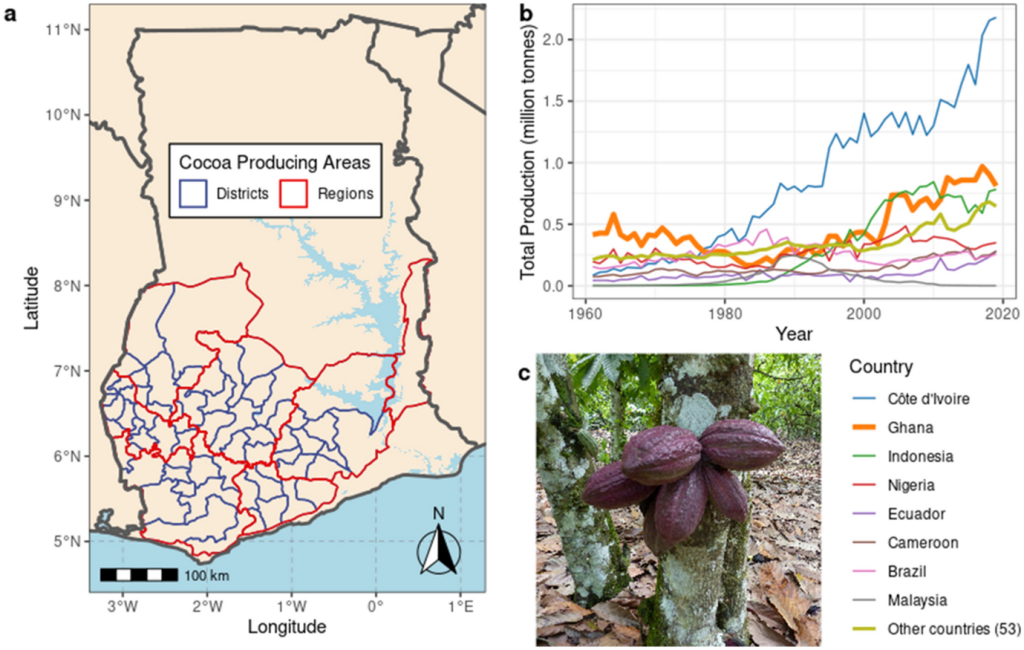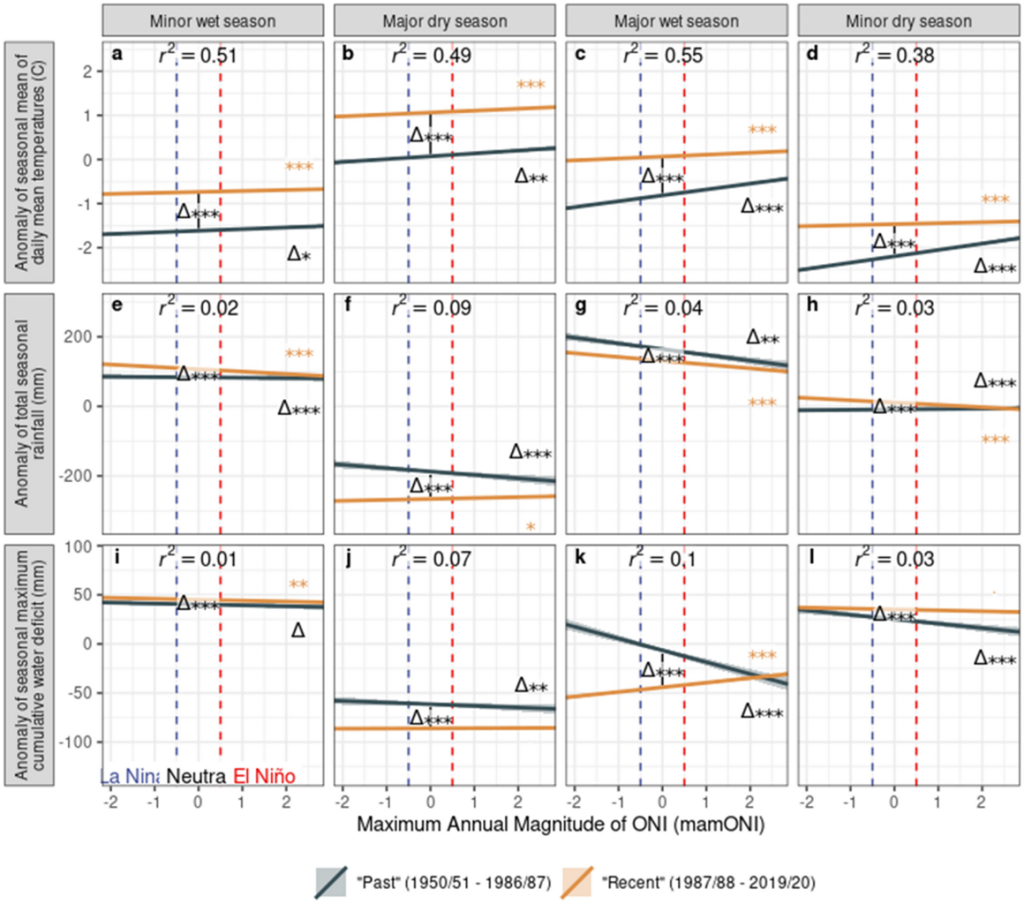World Water Day Series – Post by Dr Alexandra Morel
Ghana is one of the largest producers of cocoa (Figure 1b), a perennial tree crop, that is primarily grown by smallholder farmers. Theobroma cacao is native to Central America but was first cultivated in West Africa in the 1800s. Today cocoa beans are one of the major agricultural exports for West Africa and employs 5-6 million farmers across the tropics.

Unlike annual crops, which are planted each year (e.g. wheat, corn, soy), perennial crops (e.g. oil palm, cocoa, coffee) can show an impact to their yield the following year or for a number of years following a period of stress. This stress can be related to higher-than-average temperatures, lack of water or a combination of the two. A lack of water can be captured by a metric called “cumulative water deficit”. This estimates the shortfall of rainfall in millimetres compared to the water required to maintain plants’ metabolic and/or reproductive processes (estimated as potential evapotranspiration). It is usually calculated at the monthly scale. Trees may be able to survive this type of stress, but it will likely take a toll on their ability to produce more fruits or invest in growing their trunks, roots and leaves. In extreme cases, this level of stress can also induce a “mass fruiting” event, whereby a plant invests what carbon resources it has left into reproduction, with the assumption it may be about to die. The carbohydrates used for these events are assumed to be stored by the trees and only used in emergency situations; therefore, if a tree does use them but still survives the extreme event, they would likely be significantly less productive or vigorous for the following year or several years. This phenomenon is not well studied nor often observed at larger spatial scales yet will be an important aspect to understand for achieving climate resilience in our agricultural system.
El Niño events, driven by the El Niño Southern Oscillation (ENSO), are an example of periods when global temperatures are elevated and, depending on the region, can also cause drier conditions. Conversely, La Niña events are generally cooler with differing influences on rainfall. As ENSO is a Pacific Ocean phenomenon, the impact on West Africa is not always consistent; however, we were interested to explore whether we could observe a yield response in cocoa during and immediately following an ENSO event. For this study, led by Dr Thomas Creedy, we used the Oceanic Nino Index (ONI) as a proxy for the severity of an El Niño or La Niña event. We were able to get a large dataset of cocoa production from the Ghana Cocoa Board (COCOBOD) of annual production for the 6 cocoa buying regions of the country. This data covered the years 1947-2020. We were also able to analyse higher spatial resolution cocoa production data for 68 cocoa purchasing districts, but for a shorter time period, 1999-2020. See Figure 1a for the outline of regions (red) and districts (blue). These data were paired with gridded climate reanalysis data (ERA-5) for calculating spatially relevant anomalies of mean, minimum and maximum temperatures, total precipitation and cumulative water deficit (CWD) for the two time periods. Anomalies were helpful for understanding how far from “normal” these cocoa trees were experiencing during these climate events.
Using the higher resolution production data from the last 20 years, we saw lower cocoa yields during an El Niño event and higher cocoa yields the year following an El Niño event. This suggested that during the period of stress the cocoa trees were less able to invest in fruit or flower production but may be showing a stress response in the year after. Interestingly, this relationship was not as statistically significant for the coarser resolution production data over the 70-year study period. When we separated the study period into before 1987 and after 1988, we found a flip in the yield responses. In the earlier time period, we see cocoa yields being higher during an El Niño event and decreasing the following year. While from 1987 the yield response shifted to be consistent with the district level results, where yields are lower during the El Niño event and then are elevated the year following. We also noted that yields were higher during a La Niña event and lower the year following a La Niña during the later time period.
We were surprised to see the sign of this impact switching from positive to negative over this 70-year data set and are still investigating any differences due to management or planting history of these study regions. However, for this paper, we have also explored whether the climate conditions during extreme ENSO conditions may have changed significantly over this time period. Using the ONI and gridded ERA-5 climate data, we looked at average temperature, total rainfall and CWD anomalies for the major and minor, wet and dry seasons (Figure 2). We found that temperature anomalies were generally higher in the later time period but were consistently higher during the major dry season of an El Niño event (Figure 2b). We also found that the CWD during the major wet season was more negative (e.g. more stressful) during a La Niña than an El Niño event during the later time period, a dramatic shift from the earlier time period (Figure 2k). We drilled a bit further by month and found this shift in pattern to be statistically significant for March, April and May, which are key months for flowering and pollination of the cocoa trees (see Figure 5 of the below linked paper).

These observed shifts, suggest an overall drop in rainfall and increasingly water limited conditions for cocoa trees during both La Niña and El Niño events, with the additional stress of rapidly increasing temperatures. These smallholder farms are generally low input and dependent on rain rather than irrigation. Being able to provide more consistent water during the major wet and dry seasons for both ENSO extremes may help in maintaining more reliable yields; however, it is unclear how financially viable this will be and what the impacts would be for the local hydrology. There are also questions as to the long-term health and productivity of these cocoa trees and farms if these ENSO extremes continue to be increasingly stressful. To date, there has been significantly less investment in the research of perennial crops, which will need to change. Perennial farms today have been managed and planted in locations due to climate conditions of several decades before. They will continue to struggle to adapt to these rapidly changing climate conditions. It will require multi-disciplinary research of agronomists, ecologists, soil scientists, hydrologists, social scientists and climate scientists as well as capacity building and agronomic support for affected farmers.
I am happy to answer any questions about this work. You can reach me at amorel001@dundee.ac.uk
Reference:
Creedy, T. J., R. A. Asare, A. C. Morel, M. Hirons, J. Mason, Y. Malhi, C. L. McDermott, E. Opoku & K. Norris (2022) Climate change alters impacts of extreme climate events on a tropical perennial tree crop. Scientific Reports 12, 19653. https://doi.org/10.1038/s41598-022-22967-7
